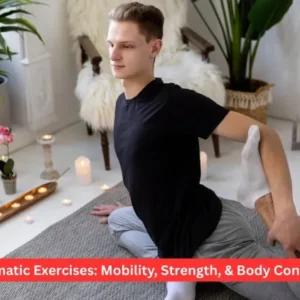Beauty and perfectly toned lower legs, including the calves and ankles, are not only appreciable, but also very helpful for physical activity, stability and the avoidance of serious lesions. Calf raises are a mass builder for the lower calf, which can be done without any equipment and can be done anywhere, anytime. If you want well-defined lower legs, then calf raises form a good part of the routine training, which besides offers many other dividends. Here are ten advantages of calf raises to explain why they should secure a place in your workout regimen.
You can view our previous article on jump squats’ benefits if you are interested in it.
-
10 Benefits of Calf Raises
- 1. Targeted Calf Development
- 2. Increased ankle strength and stability
- 3. Improved Athletic Performance
- 4. Improved Balance and Coordination
- 5. Increased Jumping Power
- 6. Reduced risk of lower leg injuries
- 7. Improved Posture
- 8. Versatility and Progression
- 9. No equipment required
- 10. Conversely, it complies easily with the routine.
- Examples of Calf Exercises
- Bottom Line
- Frequently Asked Questions
10 Benefits of Calf Raises
1. Targeted Calf Development
Muscle Focus: Calf raises mainly target the two prominent muscles that are found in the posterior part of the lower leg: the gastrocnemius and soleus muscles. The gastrocnemius is the largest of the two muscles that form the upper rounded part, which is potently seen, while the SOL muscle is located beneath the gastrocnemius and is responsible for the thickness of the calf.
Benefits: This exercise is effective in causing massive development of these areas’ muscles to have bulk, shape, and power when performed with regularity. This detailed development assists in the formation of the calves and determines how developed these muscles are, thus achieving a broader outlook on the muscularity of the calves. Generally, for head turners and functional strength, this is an essential exercise routine that ought to be integrated for the lower leg muscles.
Read more: Calf Stretches For Runners: 4 Great Stretches to Do

2. Increased ankle strength and stability
Ankle support: The muscles, tendons, and ligaments that are located in the specific area of the ankle joint play an important role in providing stability and act as support for our body during such motion. Calf raises assist in building up these structures because the calf muscles have to support the whole weight of the body through the lower body structures, like the ankle.
Benefits: Enhanced supple force of the ankle muscle decreases the probabilities of injuries like sprains and strains, particularly among athletes who engage in sporting disciplines that call for quick and frequent changes in directions, or those that involve running and jumping. In the shins, greater ankle stability helps the overall balance and coordination in any sporting activities and our day-to-day activities.
3. Improved Athletic Performance
Power and Agility: The calf and ankle muscles are very powerful and very much needed throughout any movement as sprinting or high jumping, lateral movement and much more. The calf muscles also have the other functions of moving the body forward through propulsion in toe-off or during take-off from the ground, and lastly, as absorbers of shock throughout the body.
Benefits: If you want to enhance your involvement in power, agility and balance-demanding tasks, as well as for sportsmen and women, it is important to include calf raises into your fitness schedule. For those who run, or they involved in basketball or dancing, they are likely to achieve faster running, higher leap ability, and accurate movements when the calf muscles are developed.
4. Improved Balance and Coordination
Stability Challenge: Erecting the calf raises your heels and tests your balance because you are required to stand firm while lifting and also putting the heels down. That is why this exercise would not only help stretch the calf muscles but also the stabiliser muscles in the legs as well as in the stomach.
Benefits: Doing calf raises is also essential for balance and coordination to be able to gain a better performance both off and off the field. Stability makes you capable of minimising the chances of falls and their related complications during the later years of your life, as well as to move accurately and with power throughout your body.
5. Increased Jumping Power
Explosive Strength: This is because jumping, particularly jumping power, hinges on your calf muscles ‘ well-being, particularly the strength of your lower legs. Calf raises are beneficial to the gastrocnemius and soleus muscles because they improve their force production capacity.
Benefits: Increased strength of the calf muscles enhances the ability to deliver a powerful push at the time of jumps, due to which the vertical jump capacity is high for sportsmen involved in high-jumping sports like basketball, volleyball, athletics, etc. Through its integration in the workout, it is possible to produce the power for an impressive jump and greater lower-body power.
6. Reduced risk of lower leg injuries
Impact absorption: The tissues flattened and the muscles ensiformes calf muscles give a significant contribution in absorbing impacts, in part that comprises running and jumping. Satisfactory muscle mass in the calf area ensures that such forces are well distributed, hence imposing minimal pressure on other lower leg parts such as the shins and Achilles tendon.
Benefits: Here are some benefits of performing calf raises for your body to decrease the chances of shin splinting, stress fracture, or Achilles tendonitis injuring your lower leg. Strengthening muscle groups using the guidelines of stretching increases the person’s endurance and well-being without a doubt, and enables the person to carry out their passions and hobbies without the downtime created by an injury.

7. Improved Posture
Postural Alignment: The content areas that are strongly developed are relevant to better posture since strong lower leg and foot muscles enable proper positioning of the lower extremities. He expects the distribution of the body weight and shape for the proper formation of the curves of the spine.
Benefits: Calf raises would serve the purpose of toning and building the lower leg and foot muscles, which helps to minimise the prospect of having posture errors that could cause pain or injury over time. Proper positioning of the body is also vital, despite of whether the person is in a sitting, standing or lying down position, to avoid back aches, maintain a good means of circulation, and to have good joint economy or body biomechanics about movements.
8. Versatility and Progression
Versatile: As mentioned earlier, calf raises are one of the most versatile exercise activities that can be done by everybody, be it a beginner, intermediate or a champion. Here are some of them:
Variation
- Single-Legged Calf Raises: It is a complex exercise that involves less stability, restraint, and increased difficulty of exercising on a single limb.
- Weighted Calf Raises: Using dumbbells, a barbell, or a weighted vest enhances the resistance, which presents an added advantage of more growth and strength.
- Seated Calf Raises: This targets the soleus muscle area more than the previous exercise and is recommended for individuals with balance problems that hinder them from performing the standing exercises.
- Using equipment: Following on from balance, equipment such as a Bosu ball or balance board alters the base of support and thereby introduces another level to the benefits of the exercise.
- Calf raises; the push-ups are effective in building the calf muscles since they don’t require any equipment; one can do them at home. Advantages: The information will enable one to progress and change their calf raises, hence the muscles will continue to grow and change with time, hence the no more plateaus.
9. No equipment required
Ease of use: Another advantage of standing calf raises is that one does not require any equipment to perform them. This makes them an ideal exercise for people who shield themselves from normal routines, or when one cannot access the gym or is travelling.
Advantages: For instance, you can do calf raises any time of the day, either while at home, at the landlord’s office, or even while waiting in a line, thus making this one essential lower leg exercise flexible to an individual. As with most activities, calf raises offer a level of convenience that removes all reasons that one cannot work on his/her calves.
10. Conversely, it complies easily with the routine.
Perfect fit: As with most of the exercises, calf raises can be incorporated into your regular fitness program as either an individual movement or in the lower body exercise regimen. They can also be done any time, anywhere, and can be an integral part of a particular routine one may undertake in a day, for instance while brushing or showering, waiting for a bus/matatu, or even when settled down to watch television.
Benefits: This is perhaps attributed to the fact that calf raises are extremely simple exercises, and can be performed almost anytime throughout the day to strengthen and develop the calf muscles. Hence, including calf raises in a daily program will help the individual build up their lower leg and ankle muscles without the necessity for additional time spent on exercising.

Examples of Calf Exercises
To assist you in building your calf raises in your fitness regimen, here are some types of calf exercises that are ideal for all calibres.
Beginner Calf Workout:
- Standing Double-Legged Calf Raises: complete a total of three sets by performing fifteen reps in each one. It involves body weight, making it quite easy to be done without requiring any equipment like a gym set.
- Seated Calf Raises: 3 sets of 15 reps. This kind of exercise also targets the calf muscles, and it is recommended that you use your body weight while performing it.
- Toe Walks: 3 sets of 30 seconds. It is thus easy to perform this with the body weight to increase its flexibility of being done frequently making it good for instances when you do not have the equipment. Intermediate Calf Workout:
- Single-Leg Calf Raises: 3 sets of 12 reps per leg
- Standing Weighted Calf Raises (using a dumbbell): Exercise 3: 3 sets of 15.
- Calf Stretches** Extend the calf for 30 seconds between sets **: 3 sets
- It is important to point out that most of these exercises can also be performed without equipment to facilitate their exercise. Gravitational pull is one of the ways that can be used to build calf exercises and make them stronger.
Advanced Calf Workout:
- Single-Leg Calf Raises on a Step: 4 sets of 12 reps per leg
- Seated Calf Raises (with more weights): 4 sets of 15 reps
- Duckback Calf Raises (with a partner or weight): 4 sets of 12 reps
- Jump Rope: 3 sets of 1 minute (during that 1 minute, one should be focusing on pushing with the calves)
- А: Some of these exercises may also be completed with the need for weights and can easily be done by people who do not own gym equipment. Weight bearing is useful as a way of developing and firming the calf muscles in your body.
Bottom Line
There are many reasons why people should consider performing calf raises often, since they are a very effective exercise with many benefits to the person interested in shaping and strengthening those parts of the body. From increasing muscle strength and stability in sports to preventing chances of a sprain and helping to achieve good posture posture calf raises are quite essential in the welfare of the lower calf muscles.
Thus, it is possible to perform calf raises with little or no modifications regardless of whether you are a beginner or a professional in the field. Through doing the calf raises regularly and progressive exercising, it is possible to have well-developed and strong calves and ankles to support performance in sports and other tasks.
To sum up, while performing calf raises, primary focus should be paid to regularity and gradual increase of the weights used. The fundamental exercises should be practised with an emphasis on correct form, and the recipient should progress to variations of the exercises as he or she progresses. Like the push-up, calf raises can also be done with the body weight and therefore do not require any form of equipment. Apart from enhancing the look of your lower legs, you will also enhance overall performance, balance, and lower body muscles.
Frequently Asked Questions
1. Which muscle groups does calf raises mainly work on?
Calf raises mainly focus on working the gastrocnemius and soleus muscles that are found at the back of the lower leg. The Gastrocnemius muscle is the one that makes the calf appear rounded, while the soleus is a deeper muscle that adds thickness and/or stamina to the calf.
2. Is it possible to perform calf raises without any equipment?
Yes! The first advantage of calf raises is that one does not need any equipment; it means that one can do it when there is no equipment around. People can perform them at any time, in the comfort of their own home, in offices, or even before attending a shopping queue, thus making them easy to fit into any schedule.
3. In this case, how do calf raises assist in preventing accidental incompletions?
A calf raise also leads to better calf muscle growth, which in turn helps in immobilising force on the plantar fascia and reducing shin splints, Achilles tendonitis and ankle sprains. They offer more support and stability that includes the times when one needs to move around vigorously.
4. How frequently should one perform calf raises to see the progress?
When you want to see the changes, it is wise to perform calf raises twice – four times a week and with gradual increases in reps or weights. Maintenance of the proper form and regularity is an important factor if permanent and lasting gains are to be attained.








2 thoughts on “What Is Calf Raises: 10 Great Benefits You Should Know”
That is the appropriate weblog for anybody who needs to find out about this topic. You realize a lot its virtually arduous to argue with you (not that I really would want…HaHa). You definitely put a brand new spin on a topic thats been written about for years. Nice stuff, just nice!
Thank you so much! I really appreciate your kind words and glad you enjoyed the read!